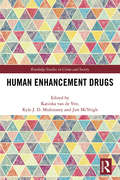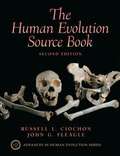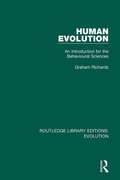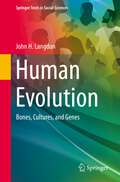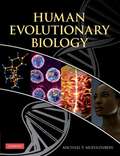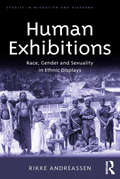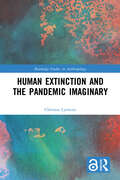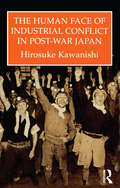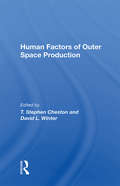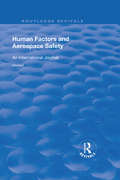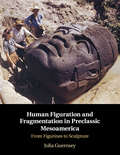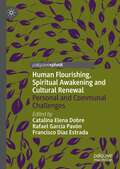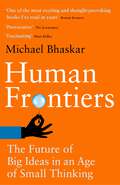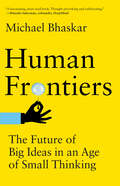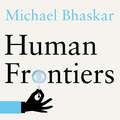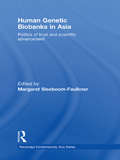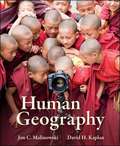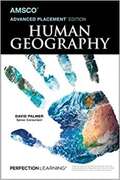- Table View
- List View
Human Ecology: Fragments Of Anti-fragmentary Views Of The World
by Dieter Steiner Markus NauserWe face an environmental catastrophe of global proportions. The ecological rationality of modern society, and of science in particular, is in question. Science still responds to crises at the level of technocratic expertise, and still treats society as an adaptive system. By bringing together a number of integrative approaches to the human-environment problem, Human Ecology shapes a more radical, fundamental agenda for change. The book creates a framework for a cohesive discourse, for a "new human ecology". From the notion that the individual person is an agent mediating between society and environment, the individual contributors recognize that the environmental crisis is really a crisis of society - manifesting itself in an increasing fragmentation of lives in general and knowledge in particular. Arguing for environmentally sustainable lifestyles, the book envisages a new kind of consciousness and a new environment.
Human Enhancement Drugs (Routledge Studies in Crime and Society)
by Katinka van de Ven Kyle J. D. Mulrooney Jim McVeighDespite increasing interest in the use of human enhancement drugs (HEDs), our understanding of this phenomenon and the regulatory framework used to address it has lagged behind. Encompassing public health, epidemiology, neuroethics, sport science, criminology, and sociology, this book brings together a broad spectrum of scholarly insights and research expertise from leading authorities to examine key international issues in the field of HEDs. As "traditional" and other "new" drug markets have occupied much of the academic attention, there has been a lack of scholarly focus on human enhancement drugs. This book provides readers with a much-needed understanding of the illicit drug market of HEDs. The authors, from a variety of cultural contexts, disciplines and perspectives, include both academics and practitioners. Topics explored in this collection amongst others include: • The anti-doping industry and performance and image enhancing drugs • Steroids and gender • The use of cognitive enhancing drugs in academia • The use of sunless synthetic tanning products • The (online) trade of HEDs • Regulations of the enhancement drugs market This collection will serve as a reference for students, academics, practitioners, law enforcement and others working in this area to reflect on the current state of research and consider future priorities. This detailed exploration will provide a valuable knowledge base for those interested in human enhancement drugs, while also promoting critical discussion.
Human Entanglement Theory: A Quantum Approach to the Study of All-Encompassing Human Communication
by Christian AspalterThis innovative book has combined the latest drive to integrate the findings and principles of quantum mechanics and quantum technology, especially here quantum computing, into the flamboyant world of social sciences. Starting with Friedrich Nietzsche as a role model, especially his “Human, All-too-Human,” the book explores the world of interpersonal and intrapersonal, intercultural and transhistorical, human communication. This book uses an innovative experiential and abductive research design. The philosophy inspired by Nietzsche meets new inspirations stemming from quantum mechanics and quantum computing in particular. Building on derived guiding principles of (fuzzy) randomness, parallelity, and universality (with communication, words and feelings, as the least common denominator), the book arrives at the formation of a new quantum-inspired theory, called the Theory of Human Entanglement, where entanglements are causal forces for human communication (and hence human actions) that either instigate and propel, or inhibit and stifle human communication (and thus human actions). Human entanglements are diverse; they are complex and accumulative in nature. They operate in a multi-dimensional space, encompassing language usage (including their hidden connotations and culturally constructed truths, such as hidden notions of good and evil, allowed and forbidden), cultural traditions and limitations, governance, institutions, court rulings and practices, particular usages of common sense, local/neighborhood culture and practices, socio-economic and environmental forces and limitations, personal situations and experiences, personal thoughts, feelings, memories and aspirations, and much more. The theory may serve as starting point for greater causality focus in research design and applications across all social sciences and far beyond, especially when dealing with high number or infinite number of potentially causal and causal variables, as well as their aggregate forces (i.e. probability-based vector forces). On top, artificial intelligence applications, quantum information, and quantum finance applications, for example, may contribute to the further development of human entanglement theory, and vice versa.
Human Evolution Source Book
by John G. Fleagle Russell L. CiochonFor Junior, Senior, and Graduate courses in Human Evolution taught in anthropology and biology departments. This book is the most comprehensive collection of cutting edge articles on human evolution. Designed for use by students in anthropology, paleontology, and evolutionary biology, this edited volume brings together the major ideas and publications on human evolution of the past three decades. The book spans the entire scope of human evolution with particular emphasis on the fossil record, including archaeological studies.
Human Evolution: An Introduction for the Behavioural Sciences (Routledge Library Editions: Evolution #10)
by Graham RichardsOriginally published in 1987, Human Evolution looks at theories of the evolution of human behaviour (contemporary at the time of publication). The book reviews competing theories of psychological and social evolution and provides a detailed historical introduction to the subject. A key theoretical concern which emerges in the book includes the psychological significance of the human evolution issue itself. The period of human evolution covered ranges from the demise of the Miocene hominoids, to the emergence of ‘civilization’. Topics covered include: functions of ‘origin myths’, history of the study of human evolution, methods and data-bases, theories of the nature of ‘hominisation’, origins of bipedalism, language and tool-use, theories of social evolution, theories of cave art and the spread of Homo sapiens to America and Australia.
Human Evolution: Bones, Cultures, and Genes (Springer Texts in Social Sciences)
by John H. LangdonThis is an introductory textbook for the study of human evolution, and covers all major topics of human origins taught under paleoanthropology, anthropology, archaeology, and evolutionary biology courses. This book differs from the existing selection of textbooks in the following ways:• It incorporates the most recent fossil discoveries and interpretations.• It balances the discussion between descriptions of fossils and interpretations of behavior of hominins in different time periods. • It includes current findings of genomics into understanding the more recent stages of human evolution. This important subdiscipline is badly underserved by current texts.• It consistently addresses the relationship of evidence to our current hypotheses and interpretations.The book has an engaging and lucid style suitable for those entering the field. Students will find ample case studies, illustrations and examples helpful in understanding difficult concepts. Tables, timelines, and maps in every chapter include data summaries and key points. The book highlights peripheral points and background concepts in side boxes for easy reference and lists key ideas at the end of each chapter. This up-to-date and easy to read text is suitable for both classroom study and self-learning.
Human Evolutionary Biology
by Michael P. MuehlenbeinWide-ranging and inclusive, this text provides an invaluable review of an expansive selection of topics in human evolution, variation and adaptability for professionals and students in biological anthropology, evolutionary biology, medical sciences and psychology. The chapters are organized around four broad themes, with sections devoted to phenotypic and genetic variation within and between human populations, reproductive physiology and behavior, growth and development, and human health from evolutionary and ecological perspectives. An introductory section provides readers with the historical, theoretical and methodological foundations needed to understand the more complex ideas presented later. Two hundred discussion questions provide starting points for class debate and assignments to test student understanding.
Human Exhibitions: Race, Gender and Sexuality in Ethnic Displays (Studies in Migration and Diaspora)
by Rikke AndreassenFrom the 1870s to the second decade of the twentieth century, more than fifty exhibitions of so-called exotic people took place in Denmark. Here large numbers of people of Asian and African origin were exhibited for the entertainment and ’education’ of a mass audience. Several of these exhibitions took place in Copenhagen Zoo, where different ’villages’, constructed in the middle of the zoo, hosted men, women and children, who sometimes stayed for months, performing their ’daily lives’ for thousands of curious Danes. This book draws on unique archival material newly discovered in Copenhagen, including photographs, documentary evidence and newspaper articles, to offer new insights and perspectives on the exhibitions both in Copenhagen and in other European cities. Employing post-colonial and feminist approaches to the material, the author sheds fresh light on the staging of exhibitions, the daily life of the exhibitees, the wider connections between shows across Europe and the thinking of the time on matters of race, science, gender and sexuality. A window onto contemporary racial understandings, Human Exhibitions presents interviews with the descendants of displayed people, connecting the attitudes and science of the past with both our (continued) modern fascination with ’the exotic’, and contemporary language and popular culture. As such, it will be of interest to scholars of sociology, anthropology and history working in the areas of gender and sexuality, race, whiteness and post-colonialism.
Human Expeditions
by Stephen Chrisomalis André CostopoulosIn its 2007 obituary of Bruce Trigger (1937-2006), the Times of London referred to the Canadian anthropologist and archaeologist as "Canada's leading prehistorian" and "one of the most influential archaeologists of his time." Trained at Yale University and a faculty member at McGill University for more than forty years, he was best known for his History of Archaeological Thought, which the Times called "monumental." Trigger inspired scholars all over the world through his questioning of assumptions and his engagement with social and political causes. Human Expeditions pays tribute to Trigger's immense legacy by bringing together cutting edge work from internationally recognized and emerging researchers inspired by his example. Covering the length and breadth of Trigger's wide-ranging interests - from Egyptology to the history of archaeological theory to North American aboriginal cultures - this volume highlights the diversity of his academic work and the magnitude of his impact in many different areas of scholarship.
Human Extinction and the Pandemic Imaginary (Routledge Studies in Anthropology)
by Christos LynterisThis book develops an examination and critique of human extinction as a result of the ‘next pandemic’ and turns attention towards the role of pandemic catastrophe in the renegotiation of what it means to be human. Nested in debates in anthropology, philosophy, social theory and global health, the book argues that fear of and fascination with the ‘next pandemic’ stem not so much from an anticipation of a biological extinction of the human species, as from an expectation of the loss of mastery over human/non-humanl relations. Christos Lynteris employs the notion of the ‘pandemic imaginary’ in order to understand the way in which pandemic-borne human extinction refashions our understanding of humanity and its place in the world. The book challenges us to think how cosmological, aesthetic, ontological and political aspects of pandemic catastrophe are intertwined. The chapters examine the vital entanglement of epidemiological studies, popular culture, modes of scientific visualisation, and pandemic preparedness campaigns. This volume will be relevant for scholars and advanced students of anthropology as well as global health, and for many others interested in catastrophe, the ‘end of the world’ and the (post)apocalyptic.
Human Extinction: A History of the Science and Ethics of Annihilation (Routledge Studies in the History of Science, Technology and Medicine)
by Émile P. TorresThis volume traces the origins and evolution of the idea of human extinction, from the ancient Presocratics through contemporary work on "existential risks." Many leading intellectuals agree that the risk of human extinction this century may be higher than at any point in our 300,000-year history as a species. This book provides insight on the key questions that inform this discussion, including when humans began to worry about their own extinction and how the debate has changed over time. It establishes a new theoretical foundation for thinking about the ethics of our extinction, arguing that extinction would be very bad under most circumstances, although the outcome might be, on balance, good. Throughout the book, graphs, tables, and images further illustrate how human choices and attitudes about extinction have evolved in Western history. In its thorough examination of humanity’s past, this book also provides a starting point for understanding our future. Although accessible enough to be read by undergraduates, Human Extinction contains new and thought-provoking research that will benefit even established academic philosophers and historians.
Human Face Of Industrial Conflict In Japan
by KawanishiFirst Published in 1998. Routledge is an imprint of Taylor & Francis, an informa company.
Human Factors Of Outer Space Production
by T. Stephen Cheston David L. WinterThe missions of the early space age--when a relatively few, very highly trained, physically fit male, pilot/astronauts operated for short times--will be supplemented in the future by missions where large numbers of nonpilot/astronaut men and women will work in orbit for long periods of time on research and industry-related tasks. The lengthening and changing complexity of space operations requires that the psychosocial, habitat design, food systems, and economic aspects of humans working in space be reviewed carefully. In this volume, an interdisciplinary group of experts addresses these aspects of space work and delineates avenues for future research.
Human Factors and Aerospace Safety: An International Journal: Volume 1 (Routledge Revivals)
by Don Harris Helen C. MuirThis title was first published in 2001. There have been significant advances in the engineering design and production standards of the hardware and electronics in commercial aircraft. It is now uncommon for the principal (or sole) cause of an aircraft accident to be a component failure. Human error is now implicated in up to 80 per cent of all civil and military aviation accidents. The human being is now arguably the least reliable component left in the system. This basic premise forms the basis for this international journal. The journal focuses specifically on the human element in the aerospace system and its role in either causing accidents or incidents, or in promoting safety. The journal solicits contributions from both academic researchers and practitioners from industry. Human factors and safety are applied sciences and this is reflected in the tone and composition of the papers in the journal.
Human Factors and Aerospace Safety: An International Journal: v.2: No.4 (Routledge Revivals Ser.)
by Don Harris Helen C. MuirThis title was first published in 2003. An international journal targeted specifically at the study of the human element in the aerospace system, and its role in either avoiding or contributing to accidents and incidents, and in promoting safe operations. The journal contains both formal research and practitioner papers, describing new research in the area of human factors and aerospace safety, and activities such as successful safety and regulatory initiatives or accident case studies. In every issue there is also an invited position paper by an internationally respected author, providing a critical overview of a particular area of human factors and aerospace safety, with the aim of developing theory and setting a research agenda for the future. Other features of the journal include: a critical incidents section describing recent aviation incidents with human factors root causes, a calendar of events, listing forthcoming international conferences, seminars and workshops of interest to the reader, and occasional book reviews.
Human Families (Social Change In Global Perspective Ser.)
by Stevan HarrellThis detailed study maps variations in family systems throughout the world, focusing on the ways families cooperate and interact with their societies. Harrell describes families in nomadic bands, traditional African societies, Polynesian and Micronesian societies, native societies of the Pacific Northwest coast, preindustrial class societies, and modern industrial societies. His extensive case studies are clearly illustrated with unique diagrams that allow comparison of complex groups and family processes extending over a generation. }This detailed study maps the variations in family systems throughout the world, focusing on the ways families interact with their societies. Tracing the developmental cycle of families in a wide range of times and places, Stevan Harrell shows how family members in different societies must cooperate to perform various activities and thus organize themselves in particular ways. Within six major divisions, the book describes families in nomadic bands, traditional African societies, Polynesian and Micronesian societies, native societies of the Pacific Northwest coast, preindustrial class societies, and modern industrial societies. Within each group, the authors copious examples demonstrate the variation from one family system to another. His case studies are clearly illustrated with a unique set of diagrams that allow comparison of complex groups and of family processes extending over a generation. Scholars and advanced students alike will find this ambitious book an invaluable resource. }
Human Figuration and Fragmentation in Preclassic Mesoamerica: From Figurines to Sculpture
by Julia GuernseyIn this book, Julia Guernsey examines the relationship between human figuration, fragmentation, bodily divisibility, personhood, and community in ancient Mesoamerica. Contending that representation of the human body in the pre-classic period gradually became a privileged act, she argues that human figuration as well as the fragmentation of both human representations and human bodies reveals ancient conceptualizations of personhood and the relationship of individual to the community. Considering ceramic figurines and stone sculpture together with archaeological data, Guernsey weaves together evidence and ideas drawn from art history, archaeology, and anthropology to construct a rich, cultural history of Mesoamerican practices of figuration and fragmentation. A methodologically innovative study, her book has ramifications for scholars working in Mesoamerica and, more generally, those interested in the significance of human representation.
Human Flourishing, Spiritual Awakening and Cultural Renewal: Personal and Communal Challenges
by Francisco Díaz Estrada Catalina Elena Dobre Rafael García PavónThis book seeks to generate a theoretical and a reflective framework to re-connect people with culture and spirituality. It seeks to recreate important links between these domains to provide interpretative, foundational, and ethical perspectives. It is distinctive in that it focusses on the challenges that humanity is facing at a cultural, social, moral, and spiritual level. It provides a philosophical understanding of humanity from a humanistic and multidisciplinary perspective (encompassing ethics, language, art/cinema, political, cultural and gender approaches) and offers a variety of ways of how we can rethink our culture and our society for the future.
Human Flow: Stories from the Global Refugee Crisis
by Weiwei AiA powerful portrait of the greatest humanitarian emergency of our time, from the director of Human FlowIn the course of making Human Flow, his epic feature documentary about the global refugee crisis, the artist Ai Weiwei and his collaborators interviewed more than 600 refugees, aid workers, politicians, activists, doctors, and local authorities in twenty-three countries around the world. A handful of those interviews were included in the film. This book presents one hundred of these conversations in their entirety, providing compelling first-person stories of the lives of those affected by the crisis and those on the front lines of working to address its immense challenges.Speaking in their own words, refugees give voice to their experiences of migrating across borders, living in refugee camps, and struggling to rebuild their lives in unfamiliar and uncertain surroundings. They talk about the dire circumstances that drove them to migrate, whether war, famine, or persecution; and their hopes and fears for the future. A wide range of related voices provides context for the historical evolution of this crisis, the challenges for regions and states, and the options for moving forward.Complete with photographs taken by Ai Weiwei while filming Human Flow, this book provides a powerful, personal, and moving account of the most urgent humanitarian crisis of our time.
Human Frontiers: The Future of Big Ideas in an Age of Small Thinking
by Michael Bhaskar'A fascinating, must-read book covering a vast array of topics from the arts to the sciences, technology to policy. This is a brilliant and thought-provoking response to one of the most critical questions of our age: how we will come up with the next generation of innovation and truly fresh ideas?'Mustafa Suleyman, cofounder of DeepMind and Google VP'Have "big ideas" and big social and economic changes disappeared from the scene? Michael Bhaskar's Human Frontiers is the best look at these all-important questions.'Tyler Cowen, author of The Great Stagnation and The Complacent Class'Michael Bhaskar explores the disturbing possibility that a complacent, cautious civilization has lost ambition and is slowly sinking into technological stagnation rather than accelerating into a magical future. He is calling for bold, adventurous innovators to go big again. A fascinating book'Matt Ridley, author of How Innovation WorksWhere next for humanity? Is our future one of endless improvement in all areas of life, from technology and travel to medicine, movies and music? Or are our best years behind us? It's easy to assume that the story of modern society is one of consistent, radical progress, but this is no longer true: more academics are researching than ever before but their work leads to fewer breakthroughs; innovation is incremental, limited to the digital sphere; the much-vaunted cure for cancer remains elusive; space travel has stalled since the heady era of the moonshot; politics is stuck in a rut, and the creative industries seem trapped in an ongoing cycle of rehashing genres and classics. The most ambitious ideas now struggle. Our great-great-great grandparents saw a series of transformative ideas revolutionise almost everything in just a few decades. Today, in contrast, short termism, risk aversion, and fractious decision making leaves the landscape timid and unimaginative.In Human Frontiers, Michael Bhaskar draws a vividly entertaining and expansive portrait of humanity's relationship with big ideas. He argues that stasis at the frontier is the result of having already pushed so far, taken easy wins and started to hit limits. But new thinking is still possible. By adopting bold global approaches, deploying cutting edge technology like AI and embracing a culture of change, we can push through and expand afresh.Perfect for anyone who has wondered why we haven't gone further, this book shows in fascinating detail how the 21st century could stall - or be the most revolutionary time in human history.
Human Frontiers: The Future of Big Ideas in an Age of Small Thinking
by Michael BhaskarWhy has the flow of big, world-changing ideas slowed down? A provocative look at what happens next at the frontiers of human knowledge.The history of humanity is the history of big ideas that expand our frontiers—from the wheel to space flight, cave painting to the massively multiplayer game, monotheistic religion to quantum theory. And yet for the past few decades, apart from a rush of new gadgets and the explosion of digital technology, world-changing ideas have been harder to come by. Since the 1970s, big ideas have happened incrementally—recycled, focused in narrow bands of innovation. In this provocative book, Michael Bhaskar looks at why the flow of big, world-changing ideas has slowed, and what this means for the future.Bhaskar argues that the challenge at the frontiers of knowledge has arisen not because we are unimaginative and bad at realizing big ideas but because we have already pushed so far. If we compare the world of our great-great-great-grandparents to ours today, we can see how a series of transformative ideas revolutionized almost everything in just a century and a half. But recently, because of short-termism, risk aversion, and fractious decision making, we have built a cautious, unimaginative world. Bhaskar shows how we can start to expand the frontier again by thinking big—embarking on the next Universal Declaration of Human Rightsor Apollo mission—and embracing change.
Human Frontiers: The Future of Big Ideas in an Age of Small Thinking
by Michael Bhaskar'A fascinating book . . . Bhaskar is a reassuringly positive and often witty guide'Observer'A fascinating, must-read book covering a vast array of topics from the arts to the sciences, technology to policy. This is a brilliant and thought-provoking response to one of the most critical questions of our age: how we will come up with the next generation of innovation and truly fresh ideas?'Mustafa Suleyman, cofounder of DeepMind and Google VP'Have "big ideas" and big social and economic changes disappeared from the scene? Michael Bhaskar's Human Frontiers is the best look at these all-important questions.'Tyler Cowen, author of The Great Stagnation and The Complacent Class'Michael Bhaskar explores the disturbing possibility that a complacent, cautious civilization has lost ambition and is slowly sinking into technological stagnation rather than accelerating into a magical future. He is calling for bold, adventurous innovators to go big again. A fascinating book'Matt Ridley, author of How Innovation WorksWhere next for humanity? Is our future one of endless improvement in all areas of life, from technology and travel to medicine, movies and music? Or are our best years behind us? It's easy to assume that the story of modern society is one of consistent, radical progress, but this is no longer true: more academics are researching than ever before but their work leads to fewer breakthroughs; innovation is incremental, limited to the digital sphere; the much-vaunted cure for cancer remains elusive; space travel has stalled since the heady era of the moonshot; politics is stuck in a rut, and the creative industries seem trapped in an ongoing cycle of rehashing genres and classics. The most ambitious ideas now struggle. Our great-great-great grandparents saw a series of transformative ideas revolutionise almost everything in just a few decades. Today, in contrast, short termism, risk aversion, and fractious decision making leaves the landscape timid and unimaginative.In Human Frontiers, Michael Bhaskar draws a vividly entertaining and expansive portrait of humanity's relationship with big ideas. He argues that stasis at the frontier is the result of having already pushed so far, taken easy wins and started to hit limits. But new thinking is still possible. By adopting bold global approaches, deploying cutting edge technology like AI and embracing a culture of change, we can push through and expand afresh.Perfect for anyone who has wondered why we haven't gone further, this book shows in fascinating detail how the 21st century could stall - or be the most revolutionary time in human history.
Human Genetic Biobanks in Asia: Politics of trust and scientific advancement (Routledge Contemporary Asia Series)
by Margaret Sleeboom-FaulknerThis volume investigates human genetic biobanking and its regulation in various Asian countries and areas, including Japan, Mainland China, Taiwan, Hong Kong, India and Indonesia.. It sheds light on how cultural, socio-political and economic factors influence the set-up of bioethical regulation for human genetic biobanks and how bioethical sensitivities surrounding biobanks are handled. Apart from placing discourses of trust in an international perspective, the comparative materials presented in this volume also put into perspective the concepts of genetic theft and exploitation, and genetic wealth and trust. This collection contains case studies of biobanking practices in societies with different needs and welfare levels, and provides insights into government strategies towards genetic resources by examining bioethics as practised at home.
Human Geography
by David Kaplan Jon Malinowski David H. KaplanGeographers believe that phenomena on the earth’s surface are not random, but rather the result of a complex series of processes going on at the local, regional, national and international scale. Human Geography, 1e by Jon Malinowksi and David Kaplan, will introduce you to how geographers attempt to make sense of the diverse reality of human populations on the Earth’s surface. Human Geography, 1e uses a modular approach. Each of the 18 chapters are divided into page “spreads” to easily allow an instructor the flexibility to customize his or her course.
Human Geography
by David L. PalmerConcise and accessible text structured and written to follow the current AP Course and Exam Description. Examine how human behavior transforms the earth's surface in response to changing social, cultural, and political needs in short, focused sections. <P><P>The text covers all topic areas for the AP Human Geography course and examines current events and key theoretical areas such as environmental determinism and psychogeography.

